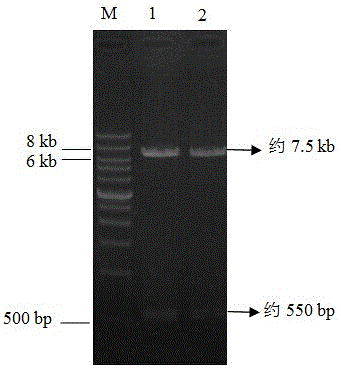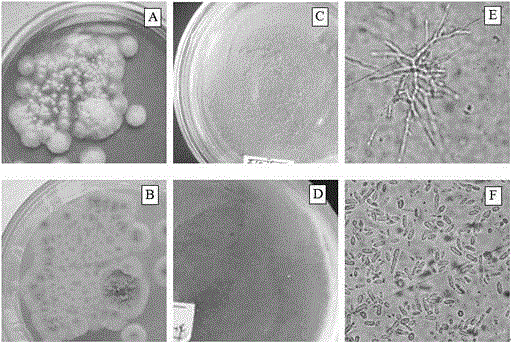A kind of gene recombination Corynesium fumigatus if01 GM and its application
A Corynebacterium and gene recombination technology, applied in the application, recombinant DNA technology, fungi and other directions, can solve the problems of genetically improved insect-producing fungal strains and other problems, and achieve good popularization and application value, fast insecticidal effect, and good The effect of continuous development promotion
- Summary
- Abstract
- Description
- Claims
- Application Information
AI Technical Summary
Problems solved by technology
Method used
Image
Examples
Embodiment 1
[0047] Example 1 Construction of recombinant plasmids
[0048] The target gene used in the present invention, the TLR7 gene of Bemisia tabaci, was obtained from the sequence of the transcriptome of Bemisia tabaci (Unigene database: Unigene20701_B4592195), and its nucleotide sequence is shown in SEQ ID NO:10.
[0049] The present invention transforms a partial fragment of the TLR7 gene of Bemisia tabaci (its nucleotide sequence is shown in SEQ ID NO.1) into a strain of Corynesporium fumigatus to obtain a genetically recombined strain of Corynesporium fumigatus. The specific operation steps are as follows:
[0050] 1. Obtain the target fragment
[0051] (1) The present invention designs the primers TLR7F and TLR7R of the target gene, that is, the TLR7 gene of Bemisia tabaci.
[0052] The nucleotide sequence of the primer TLR7F is shown in SEQ ID NO.2, and the nucleotide sequence of TLR7R is shown in SEQ ID NO.3.
[0053] (2) The total RNA of B. tabaci was extracted by the Tri...
Embodiment 2
[0065] Example 2 Construction and Screening of Recombinant Strains
[0066] 1. Obtain the protoplasts of Corynespora fumigatus IfB01 strain
[0067] The strain of Corynespora fumigatus IfB01 used has been disclosed in the patent application number 201210449949.0.
[0068] The steps to obtain protoplasts are as follows:
[0069] (1) The conidia of Corynespora fumigatus IfB01 strain were prepared with 0.05% (v / v) Tween-80 solution to a concentration of 10 8 per mL of spore suspension.
[0070] (2) Take 1 mL of the suspension and inoculate it in 100 mL of potato dextrose liquid medium (PD), and incubate at 25 °C with shaking at 150 rpm for 30 h.
[0071] (3) Take the bacterial solution in a centrifuge tube, centrifuge at 5,000 rpm for 10 min, discard the supernatant, wash twice with 0.7 mol / L NaCl solution, and then centrifuge to obtain mycelium.
[0072] (4) Add a mixed enzymolysis solution of 1% (w / v) helicase and 2% (w / v) cellulase, enzymolyze the mycelia, and filter the e...
Embodiment 3
[0091] Example 3 Toxicity Test of Recombinant Corynespora fumigatus If01 GM
[0092] Under indoor conditions, isolated hibiscus leaves with 2nd instar B. tabaci nymphs (not less than 30 nymphs per leaf) were separated at 2.0×10 by dipping method. 7 conidia / mL, 1.0×10 7 conidia / mL, 5.0×10 6 conidia / mL, 2.5×10 6 conidia / mL, 1.25×10 6 conidia / mL conidia suspension of recombinant Corynesporium fumigatus If01 GM conidia suspension was soaked for 10 s, dried and placed in a Petri dish (wet filter paper at the bottom, wet cotton balls wrapped around the petiole base) , and then put the petri dish into light at 14:10 (L:D) and culture at a temperature of 25±1°C, and the experiment was repeated 3 times.
[0093] Observe and record the death of nymphs every 2 days, and calculate the mortality and half-lethal concentration (LC) 50 ) and half-lethal time (LT 50 ).
[0094] The results are shown in Table 1, Table 2 and Table 3. The results showed that the spore concentration w...
PUM
 Login to View More
Login to View More Abstract
Description
Claims
Application Information
 Login to View More
Login to View More - Generate Ideas
- Intellectual Property
- Life Sciences
- Materials
- Tech Scout
- Unparalleled Data Quality
- Higher Quality Content
- 60% Fewer Hallucinations
Browse by: Latest US Patents, China's latest patents, Technical Efficacy Thesaurus, Application Domain, Technology Topic, Popular Technical Reports.
© 2025 PatSnap. All rights reserved.Legal|Privacy policy|Modern Slavery Act Transparency Statement|Sitemap|About US| Contact US: help@patsnap.com



